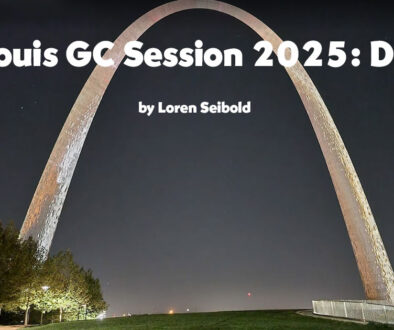#NADYEM16, Day 3: Quid Pro Quo and Financial Frustration
by Loren Seibold, 30 October 2016.
I was wrong: I told you on Friday that the NADYEM16 would be continuing the discussion of the Unity and Mission procedure on Sunday. However, the first thing that happened was a decision to put it off until Monday.
Church Governance, instead: Last year a special commission gave a report on church governance which included the astonishing fact that if we eliminated the conferences and let the churches be governed and paid by the unions (easily done with the current technology) the NAD would save (wait for it) $125,000,000 every year. Yeah, that’s One Hundred and Twenty-five Million Dollars every year! Although everyone thought $125,000,000 extra for outreach and mission every year would be great, almost immediately some rose to say, “…except in our special situation.” Eliminate everyone else’s conferences and save money, but not ours.
The simple fact is this: people are tribal, and they don’t want anyone to threaten their tribe, or their leadership of the tribe, even if a spreadsheet shows the organization would do better another way. Note that nearly all attempts to combine congregations, conferences or schools fail, even when you can prove obvious economies.
However, there were other parts of the church governance report that had to do with redistribution of money. That’s what came up today.
To this very day, the NAD is not a division in the same sense that other divisions are divisions. Every division in the world church is an independent entity that sends 2% of its gross tithe to support the General Conference. Except the North American Division. Our division for years sent more than 10% of our tithe to the GC, and only in recent years has it dropped down to around 6 or 7%. The NAD doesn’t have autonomy in the same sense that, say, the Australasian Division does; it remains more closely linked to the General Conference. In the past few years it’s claimed a bit of independence, and will soon move to its own office. But the NAD still operates under a different contract than other parts of the world church.
Most North American Adventists, and their leaders, feel an obligation to the world church. We think of ourselves (as Dan Jackson said yesterday) as sponsors of the world church. On the other hand, as the world church has grown in strength, numbers and influence, the relationship has shifted. We’re still sending more of our resources to support the world church. But when we need consideration for our unique cultural needs—women’s ordination, for example—the world church digs in its feet.
That’s what came up on Sunday. It didn’t take long, after the discussion of tithe redistribution began, for someone to come to a microphone and say, “Why are we sending the GC so much more than everyone else does? We have lots of needs here that we need to address!”
I’ve been to Asia and Africa. I know what the church is like there. There are pastors with several dozen congregations, workers supporting their families on nearly nothing. Ditto schoolteachers. (Not surprisingly, given the way political leadership has been done in a lot of these what-we-used-to-call Third World countries, leadership in the church is also more entitled and imperious than it is here.) So I begin to squirm a bit when I hear people talking like that. I don’t want to be selfish. Yes, we have needs, but theirs are more acute—and, they’re growing in number, and we’re not!
But after all the discomfort the NAD has endured over the refusal of other parts of the world church to cooperate with our cultural needs, well, I’ll be darned if I haven’t developed some sympathy for that point of view. Why, indeed, be the biggest contributor—yet the NAD can’t be taken seriously when we say what cultural accommodations we need to make our churches thrive? Women’s ordination is just a symbol of the way our culture diverges from the rest of the world, differences that some refuse to recognize, and that our General Conference leaders, who should be looking for a win-win solution to this, instead appear to inflame.
It’s hard to know all the reasons we’ve ended up at this fix. There are genuine cultural differences. And theological differences. Or (as Elder Jackson implied yesterday) ecclesiological differences. And probably resentments built up over many years in the poorer but more rapidly growing parts of the world church. And let’s be honest, resentments on our part, too: we in North America have followed our culture in being more suspicious of “the other” (other colors, languages, religions) than we once were, back when we were their teachers and sponsors. Back when “those people” stayed “over there”. Back when the world couldn’t outvote us at a GC session. And, Elder Wilson’s black-white, win-lose, bring-on-the-shaking leadership hasn’t helped.
Fair play. So the whole morning session had a whiff of quid pro quo. Everyone was thinking it. And a few saying it right out loud. It went so far as a delegate making a motion that by 2020 the NAD pays the GC 2% just like everyone else. (It wasn’t successful because, Elder Jackson explained, the amount of remittance was set by GC policy, and it was better negotiated than voted.)
Recommendations. Late morning and afternoon, the session considered some specific recommendations. The first won’t surprise you: encourage stewardship in several specific ways. Who can argue with that?
The second was to increase the number of offerings for the local church from 24 to 28.
You have all have heard at church “the offering for today is for Oakwood University” (or world missions or, several other things.) And then a couple of times a month: “the offering for today is for local church budget.” This is from a schedule sent out by the NAD to every congregation.
It is based on an obsolete 19th-century idea of people dropping in the plate their pennies and quarters and dimes, and then everything in the plate is sent to whatever target was announced. You must understand, though, that if NAD congregations had to depend on the change dropped into the offering plate, most would fold before Wednesday night’s prayer meeting. Every congregation depends on large checks placed in envelopes by faithful givers, who then receive a tax deduction. The money given to scheduled offerings is insignificant in comparison.
All that this proposal offers is that rather than the twice-monthly loose offering for church budget, we’ll now have four more Sabbaths each year when the announced offering is for church budget. Is this going to matter? Not much, though perhaps it’s symbolic. (At least one church I know of takes up every offering for the local church budget, and tells people that if they want to give to the offering of the day, they can mark that on the envelope.)
The third and fourth recommendations are so complicated that I’m not going to be able to explain them, because I didn’t understand them very well, and most everyone in the room, conference and union officers, didn’t understand them either. Even when the session broke up into small groups to discuss it, the leader of the group I sat in on said, “Can anyone explain this to me?”
The third recommendation (not yet voted) had to do with taking some monies that are usually sent up the church ladder only to be sent back down again, and just keeping them at the local conference. For example, rather than sending 1.25% of a conference’s tithe up the chain for evangelism, and then getting it back again, the conference keeps its 1.25% of tithe and promises to spend it on evangelism. Ditto with a K-12 remittance.
One part I couldn’t figure out was that rather than send .3% of the conference’s tithe to the NAD to invest in workers’ retirement fund, instead, the conference gets to send that .3% directly to the retirement fund! Given that each conference spends something like 15% of its income for the retirement of its pastors and teachers, what’s the advantage of letting the conference send in .3% itself? It’s like your car lender saying, “We’ll do automatic withdrawal for $490 of your $500 car payment, but guess what? You get to send in $10 by check every month, written out with your own hand in your own checkbook! Doesn’t that make you feel empowered?”
(I may have completely misunderstood this, though if so, I was one of many. Should anyone from the YEM read this and can explain it, please do, and I’ll gladly confess my ignorance.)
A couple more parts of this: One that I think we all thought we understood was that over time the conferences would get to keep 1% more of the tithe than they have in the past. The proposal even mentioned that it should be invested in local ministry, though it didn’t say exactly how. (I say I thought I understood it, because it seemed relatively straightforward—until someone tried to explain it, then I was drifting again.)
Perhaps one of the most important parts was a new proposal for how much each conference in the NAD would eventually share with the rest of the church. The targets: by 2020, the goal is that your union will get 3% of your conference’s tithe, your division 4%, the GC 4%, and a “special assistance” fund 1% (I have no idea what that is, and no one ever defined it). This means the conference keeps 88% of its tithe.
This is mostly important in that it reduces the share sent to the GC by several percentage points below what it is now. It’s not the 2% that other world divisions give the GC, but it’s a lot less than the NAD gives now. (But I did wonder why this was being voted, when not long before it was argued that it was better to negotiate it.)
Concluding thoughts: This was one of the most important matters that the NAD could be studying and talking about right now. It may sound petty, a percent here, two there—but those percents add up to millions and millions of dollars. (It makes me think of a quotation attributed to Senator Everett Dirksen: “A billion here, a billion there, pretty soon, you’re talking real money.”)
I’m appreciative of those who put the work in to try to make some progress on these matters. It’s hard, its complicated, it’s as tangled as a nest of garter snakes. But I suspect at the end of the day the people on the platform realized that it had been an awkward roll-out of something that should have been one of the most significant discussions in the history of the North American Division of the Seventh-day Adventist Church. The day ended with everyone—people far smarter than me, people well-versed in finances and policy—throwing up their hands in exasperation.
As I said yesterday, I have never felt as much as I have this week the fragility, the vulnerability, of the Seventh-day Adventist church. Yesterday it was culture wars. Today it was the feeling that we’ve become too complicated to understand ourselves. I suspect this is what happens when organizations grow so large they get stuck in their own swamp; when they get so entangled in policy and bureaucracy that it becomes difficult for anyone to understand what’s going on, much less explain it. It’s why the United States federal tax code is 10 million words long, and no one understands more than a fraction of it. Nor can we figure out how to stay within policy if no one really grasps the policy—which makes all the more ironic the GC’s determination to impose on the North American division an insensitive and divisive policy about women’s ordination.
Loren Seibold is the Executive Editor of Adventist Today.




